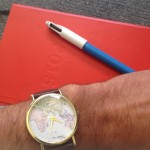As a result of quite an inspiring reading assigned to us for our media class I have been putting in the effort simply to notice things. John Mason suggests in his piece “the discipline of noticing” I have repeated to myself upon entering/exiting a doorway that “I am walking through a doorway”. Not only does it make you realise how utterly reliant you have become on doorways in everyday venture but also makes a wonderful conversation starter as you hold up a line at public toilets.
Among other things I have noticed that my analog watch doesn’t have numbers or symbols, it does however have a scale replica of half the earth and accurate lines of longitude and latitude. I have noticed that I most often use the black side of my pen, but the red is my most favoured to click in times of boredom or brain-naps. These are a few things that I have “set myself” to notice which Mason points out is the first step towards noticing as it shows intention, however it is not always reliable.
Over the past few years I have tried to set myself to remember to put my phone on the charge before bed, check the mail everyday and look at the best before date before putting the milk into my tea, all with limited success. Sometimes consequences can vary, from getting in the principals bad books for forgetting to pick up your child to having to rinse out a mug with an unpleasant smell. It goes to show that while we may think we are on top of things, we are most likely on top of 30% of things which we have selectively noticed and absorbed while happily oblivious to the 70% of clothes left on the line before a storm and assignments due by the end of the week.
Mason categorises our interactions into three categories:
Noticing, Marking and Recording.
Noticing, whether consciously or not, is isolating something you sense (see, hear, touch, smell or feel) from other stimulus around it. Being able to at the time establish a clear distinction of what it is and certainly what it isn’t, what makes it different from its surroundings. Things we notice can easily be lost in the background of our thoughts until another interaction encourages its reprisal to the forefront of our mind.
Marking is the next level of interaction which requires more focus, attention and processing. Something we ‘mark’ we can source ourselves to “remark” to somebody in conversation. This action of reproducing the fact that we noticed and mark will make it more memorable and accessible for further reflection later on.
Finally, recording is the third level of interactive noticing. This upper level often relies on immediate relaying of informational to an external source. This could simply mean jotting down a note for later, drawing a small diagram or taking a picture for concrete evidence to access. Recording requires the most motivation as compared to the intention of “setting yourself” it requires you to immediately engage and enact with your markings.
Over the next few days I will continue setting myself trivialities to notice and hopefully that will lead to increased potential for marking and consciously I am applying myself to record, for uni if not anything else. Now if you’ll excuse me I am walking through a doorway that leads to my bed.
